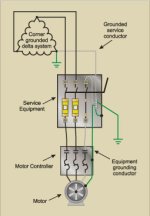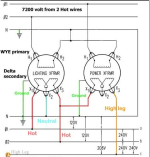kwired
Electron manager
- Location
- NE Nebraska
- Occupation
- EC
Before we had VFD's and other electronic items that are basically intended to operate on wye systems with equal volts to ground on each conductor it maybe made more sense to some degree. 277 volt lighting might been about the only thing that would cause a definite need for a system with that voltage. Otherwise all your motors or other higher power loads were 480 volts and everything else was separately derived from 120/240 single phase or 208/120 three phase system.Same here, I worked on very old mill building with a corner grounded 480.
The only thing fed out of the main switch-gear was the three elevators and two other new transformers (208 & 480 y), I always asked why it was originally used as everything else in the building was fed from the 480y277 or 208y120 transformer nobody ever had an answer. Anyone know the history on why you'd need one?
Now one the more common places to see a corner ground on something rather new would be if it is separately derived on site from a back fed delta-wye transformer where you have no neutral on the delta side of the transformer. Most the time such setups are feeding specific load and not so much a general distribution system at a facility.



